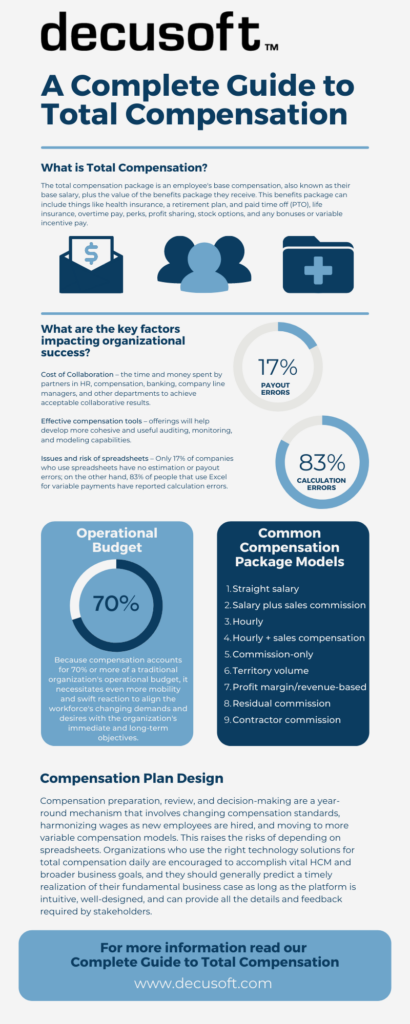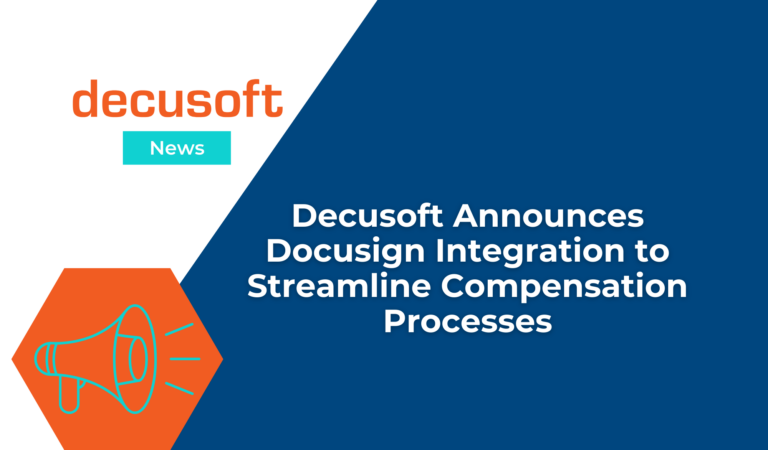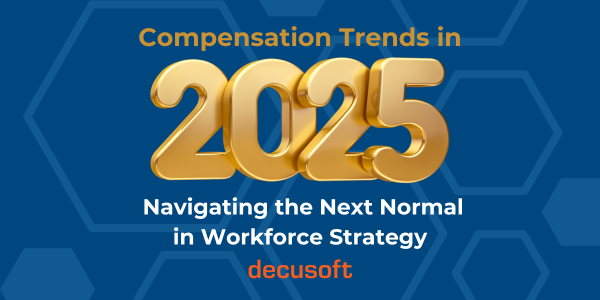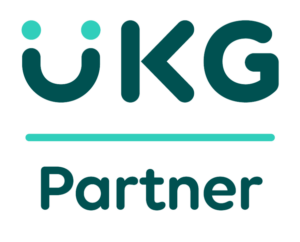What is Total Compensation?
The total compensation package is an employee’s base compensation, also known as their base salary, plus the value of the benefits package they receive. This benefits package can include things like health insurance, a retirement plan, and paid time off (PTO), life insurance, overtime pay, perks, profit sharing, stock options, and any bonuses or variable incentive pay. The best strategy for executive total compensation is unique to every business. Each organization must find the right balance between employee compensation in base pay and employee benefits in their compensation strategy while remaining competitive with other companies in your industry. This DecuSoft guide will discuss trends in total compensation management and how to create a successful and agile total compensation strategy.
Trends in Total Compensation Management
Business strategy performance generators have shifted in recent years. Although staff growth, creativity, cost control, and efficient processes will still be essential, market imperatives such as agility, enterprise-wide integration, and transparency have become top priorities for executives. Employee engagement is another critical part of the complete executive compensation strategy. These issues have become increasingly important in recent years. There is now a prerequisite for being able to succeed in unpredictably evolving market conditions. Also, there is now an understanding that good businesses do not exist in functional silos but encourage employees to collaborate toward shared goals and objectives. Many companies have seen their compensation philosophy evolve in recent years to reflect this shift.
There is also an increased emphasis on business ideals as a means of attracting and retaining top talent. Given these trends, one field of human resource management in particular – human capital management – continues to get a lot of attention: total rewards or total compensation management (total compensation). Because compensation accounts for 70% or more of a traditional organization’s operational budget, it necessitates even more mobility and swift reaction to align the workforce’s changing demands and desires with the organization’s immediate and long-term objectives.
Total Rewards Program Trends
Total compensation recognizes all forms of rewards in the preparation, production, execution, and communication of incentives within the enterprise as a discipline. Designing and administering different forms of cash and non-cash rewards, delivering strategies and individual offers that draw the best candidates while ensuring regulatory enforcement and pay equity, and the ability to implement responsive criteria when applicable internal and external evidence presents themselves have all become dynamic elements. However, the amount of sophistication for organizations trying to optimize these components has increased significantly.
Common Compensation Package Models
- Straight salary
- Salary plus sales commission
- Hourly (May be minimum wage or above)
- Hourly rate plus sales compensation
- Commission-only
- Territory volume
- Profit margin/revenue-based
- Residual commission
- Contractor commission
Increased market volatility necessitates pivoting rapidly with incentive arrangements when attempting to personalize facets of the employee experience, such as benefit components, reward frequency, and the addition of non-monetary incentives for work-life balance (e.g., job scheduling versatility or professional growth opportunities) in the total compensation strategy.
All of this refers to the definition of “compensation agility.” To dynamically represent and incorporate results, insights, and guidance from all related corporate teams, today’s compensation analysis and decision processes must be more iterative and collaborative. When an enterprise loses this incentive agility, which is marked by lengthy assessment times and a lack of coordination between HR professionals, the finance team, and leadership, market results are often jeopardized.
What are the key factors impacting organizational success?
Cost of Collaboration – The time and money spent by partners in HR, compensation, banking, company line managers, and other departments to achieve acceptable collaborative results.
Effective Compensation Tools – Offerings will help develop more cohesive and useful auditing, monitoring, and modeling capabilities.
Issues and Risk of Spreadsheets – Only 17% of companies who use spreadsheets have no estimation or payout errors; on the other hand, 83% of people that use Excel for variable payments have reported calculation errors.
Total Compensation Management Solutions
Deploying an enterprise-grade, purpose-built software tool that allows a CFO to easily access reliable data and conduct contingency preparation while working with related HR peers is crucial to increase operational agility within total compensation processes. The use of a dedicated compensation management tool removes inaccuracies and inefficiencies in the compensation process, allowing total compensation to make better-informed decisions. Many companies do use spreadsheets to handle this job, and our total compensation Benchmark Research shows that those that do experience efficiency losses as a result of spreadsheet use.
Companies have gradually recognized that spreadsheet use results in more time expended, more errors, fewer defensible decisions, and lower process performance. This is attributed to a combination of operational considerations, such as spreadsheet users’ propensity for cutting and pasting data through applications, and systemic issues, such as the lack of a centralized “data lens view” of all the sources that should be included in the decision-making process.
Compensation Plan Design
Fortunately, today’s corporate world has best-in-class enterprise infrastructure solutions that are expressly tailored to meet the challenges, needs, and nuances associated with wage administration. These tools are commonly used in organizations that emphasize mobility, openness, teamwork, and responsible decision-making. Because of the large scale of the total compensation budget, total compensation operations can not be crammed into a “four-to-six-week” timeframe or carried out using low-tech resources.
Compensation preparation, review, and decision-making are a year-round mechanism that involves changing compensation standards, harmonizing wages as new employees are hired, and moving to more variable compensation models. This raises the risks of depending on spreadsheets. Organizations who use the right technology solutions for total compensation daily are encouraged to accomplish vital HCM and broader business goals, and they should generally predict a timely realization of their fundamental business case as long as the platform is intuitive, well-designed, and can provide all the details and feedback required by stakeholders.
Owing to the various factors that could successfully handle the overall pay process, designing a comprehensive compensation plan can be difficult. Consequently, cross-departmental coordination and the opportunity to balance HCM and the rest of the organization’s goals are essential. With the right supporting technologies, this dynamic mechanism can be transformed into a more effective and valuable process for the enterprise, resulting in success for all.





